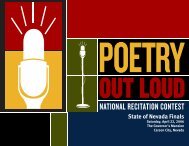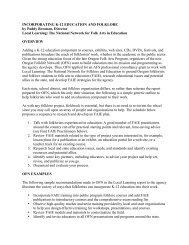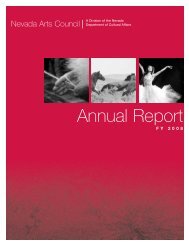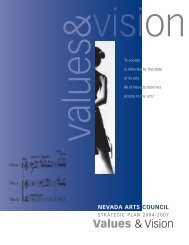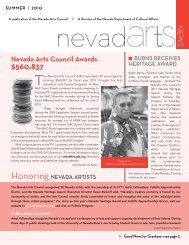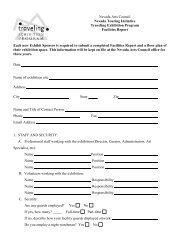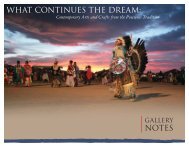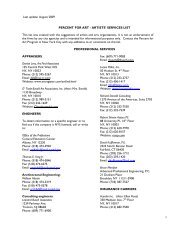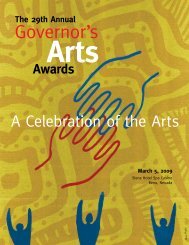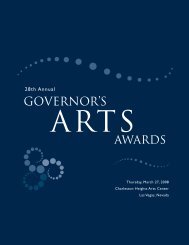Handed Down - Nevada Arts Council
Handed Down - Nevada Arts Council
Handed Down - Nevada Arts Council
You also want an ePaper? Increase the reach of your titles
YUMPU automatically turns print PDFs into web optimized ePapers that Google loves.
1989–1990<br />
Paiute-Shoshone Songs:<br />
Art Cavanaugh and Steve Kane<br />
With the decline of Native American languages,<br />
the growing influence of pan-Indian pow-wow<br />
drumming and dancing, and the pressures of modern<br />
American life, traditional Shoshone and Paiute singing<br />
is becoming an endangered art. The old songs were<br />
sung in groups to accompany round dances, although<br />
in recent years small hand drums were added to provide<br />
volume since fewer singers knew the songs.<br />
Art Cavanaugh of Winnemucca is one of perhaps<br />
half a dozen traditional round dance singers in <strong>Nevada</strong>,<br />
and with his powerful voice and extensive repertoire<br />
certainly one of the best. His father was a singer, and<br />
traditional music and stories were an important form<br />
of entertainment when Art was growing up. He says,<br />
“So I listened, I put it in my head, I guess, and it stayed<br />
there. That’s where I learned, all these things from stories,<br />
how to conduct yourself, your life, all these are told<br />
through stories, through the coyote stories that tell you<br />
not to do this, not to do that. That’s how you grow<br />
up, knowing the difference between right and wrong is<br />
what they teach you. You have the ability to determine<br />
your own life, which way you want to go—go bad or be<br />
good.”<br />
When Steve Kane of Reno heard that Art would be<br />
in the area for awhile, he jumped at the chance to spend<br />
time with him learning songs and techniques. Steve’s<br />
mother’s family was from Pyramid Lake and as a child<br />
he listened to an uncle who was a well-known handdrum<br />
singer. “He had the kind of voice that would put<br />
goose bumps on your back,” he says. Steve put his Indian<br />
heritage aside for awhile while he was in college,<br />
but he has now returned to it and renewed<br />
his interest in the culture and<br />
particularly the songs.<br />
Many of the songs are about nature—streams, forests,<br />
birds, stars—although more modern ones have also<br />
been written on such subjects as the American flag, and<br />
Art and his wife Barbara are translating some hymns<br />
into Paiute and Shoshone. Traditional dances start late<br />
in the evening, and often go until sunrise without the<br />
same song being repeated. Steve describes such a dance:<br />
“That’s really a unique experience, it’s like being high<br />
on something, you know, when you sing all night. The<br />
way Art sings his songs, the way they used to do it a<br />
long time ago, is they’d dance all night in a circle. It’s a<br />
fast type of step too, you can imagine doing it all night,<br />
it’s like you get into a trance. You reach a point where<br />
you get so tired, you know, you think that you can’t go<br />
on, but your adrenaline’s going, you just kind of keep<br />
pushing on, and you can go on all night.”<br />
It is sometimes a hard balancing act for Native<br />
American people to maintain their traditional beliefs<br />
and values while still be a part of contemporary life, and<br />
the efforts of people like Art and Steve are crucial in<br />
that task. “Indian people are tough,” Steve says. “I think<br />
the thing that’s kept us different is the songs, the culture,<br />
the language…if we ever lose that, we’re just like<br />
anybody else, we’ve lost our uniqueness.”<br />
Steve Kane<br />
Art Cavanaugh<br />
11



